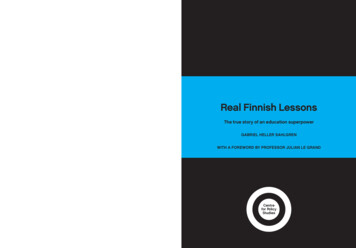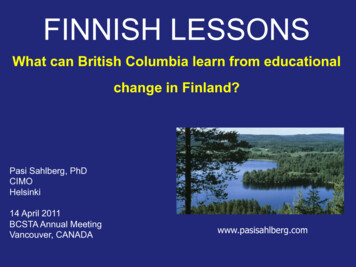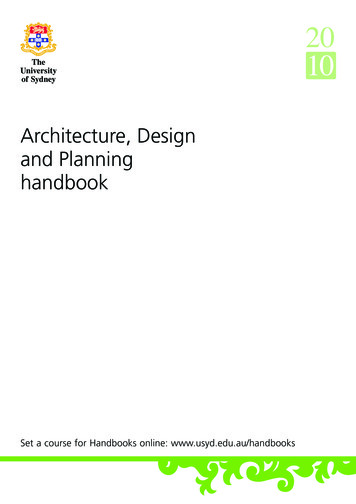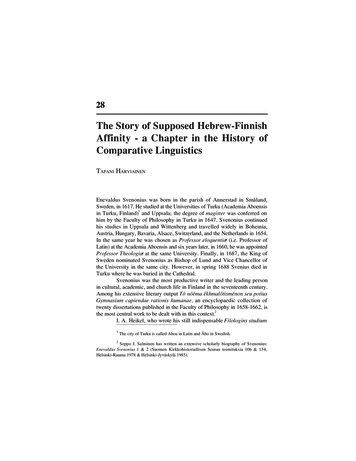
Transcription
Why did Finland’s pupils do so well? Popular explanations include the country’s focus onequity, the high standard of teacher training, a comparatively low workload, and the lackof market reforms and school accountability. But research does not support any of theseconclusions. In fact, Finland’s rise began well before most of these policies were able to takeeffect – and its recent decline started soon after they took hold.Instead, Finland’s success appears to be the result of deep-rooted historical, socioeconomic and cultural factors, combined with a resistance to the rising global tide ofprogressive teaching methods. Its current fall can in turn be linked to cultural changesand recent reforms which may have undermined the causes of its achievements. Thefindings of this monograph shed new light on Finland’s educational performance andprovide important lessons for policymakers.Centrefor PolicyStudiesReal Finnish LessonsThe true story of an education superpowerGABRIEL HELLER SAHLGRENWITH A FOREWORD BY PROFESSOR JULIAN LE GRANDGABRIEL HELLER SAHLGRENPrice 10.00REAL FINNISH LESSONSSince Finland’s top ranking in the first international PISA league tables in 2001,policymakers from around the world have tried to learn from the unexpected andextraordinary success of its education system.Centrefor PolicyStudies
Real Finnish LessonsThe true story of an education superpowerGABRIEL HELLER SAHLGRENWITH A FOREWORD BY PROFESSOR JULIAN LE GRAND
THE AUTHORGabriel Heller Sahlgren is research director at the Centre forthe Study of Market Reform of Education (CMRE), an affiliatedresearch fellow at the Research Institute of IndustrialEconomics in Stockholm, Sweden, and a PhD student at theLondon School of Economics. He is the author of numerouspublications on issues relating to applied microeconomics,including Incentivising Excellence: School Choice andEducation Quality (CMRE and IEA 2013).AcknowledgementsThe author thanks Charlotte Fox, Jonathan Friedman,Henrik Jordahl, Sirkku Kupiainen, Neil McIntosh, Tim Oates,and (especially) Tino Sanandaji for helpful comments andsuggestions.This monograph is the winner of the 2014 Charles DouglasHome Memorial Trust Award, an annual prize established topromote the ideals of freedom and democracy. Supporttowards research for this report was given by the Institutefor Policy Research.ISBN No. 978-1-910627-08-2 Centre for Policy Studies, April 2015Printed by 4 Print, 138 Molesey Avenue, Surrey
CONTENTSSummaryForeword1. Introduction12. From Poster Child to Ominous Slippage43. Questioning the Fashionable Policy Explanations74. The Iron Cage of History185. The Times They Are A-Changin’496. Lessons from Finland?63Endnotesi
SUMMARY In the first international PISA league tables, published by theOECD in 2001, Finland achieved top positions in mathematical,reading, and scientific literacy. Since then, policymakers fromaround the world have tried to learn from its extraordinary andunexpected success. However, Finnish scores in all domainsslipped in PISA 2009, and to an even greater degree in PISA2012. Why did Finland achieve such success in PISA? The standardpolicy explanations for the country’s rise include its focus onequity, with the comprehensive school reform of the 1970s asthe bedrock, and the absence of standardised tests,accountability, and market reforms. Other explanationshighlight comparatively little school- and homework, and thecountry’s current teacher education system. Yet there is little hard evidence for any of the standardexplanations – in fact, most research explicitly does notsupport them.ii
Furthermore, a closer examination of Finland’s results overtime reveals that its rise began well before most of thehighlighted policies were able to take effect. For example, thelack of accountability and the high level of autonomy forschools and teachers are recent phenomena. Up until the1990s, the Finnish education system was centralised and hadlittle autonomy. Finland’s complicated and unique history appears to be animportant explanation for its educational success, not least viathe high social status and quality of teachers. This dates backto their distinctive role in the nation-building process,beginning in the 19th century, and is therefore unlikely to becaused by current policies. Finland was also a comparatively “late developer” in terms ofindustrialisation, economic growth, rollout of mass education,and development of a welfare state. As a result, Finnish culturefor long remained more traditional than in other Nordiccountries, reflecting its similarities with high-performing EastAsian nations. This is likely to have underpinned the country’simprovements in international tests via a “wealth effect”, whichfirst increases and later decreases educational performanceas a function of income. In education, the special socio-economic and culturaltrajectory meant that a hierarchical and traditional schoolingclimate remained largely in place until relatively recently.Perhaps most conspicuous, pupil-led teaching methods lly, an increasing body of research suggests thattraditional methods are superior for raising pupil achievement.iii
The recent fall in performance may in part be explained by thefact that many of the above preconditions for success are nowbeing eroded. The country’s culture is catching up with theradical economic transformation that took place in the secondhalf of the 20th century. In particular, the traditional andteacher-centred educational culture is being replaced bymore pupil-led ways of working. While a degree of caution in seeking lessons from Finland’ssuccess is always necessary, the in-depth analysis in thismonograph shows that existing popular explanations for thecountry’s achievements, such as its lack of market reforms andaccountability, do not withstand scrutiny. Instead, it suggeststhat the country’s rise was to a large extent shaped by socioeconomic and historical factors, as well as the retention of atraditional educational culture.iv
FOREWORDFor the last decade or so, Finland’s education system has been aposter child for many education experts and policymakersthroughout the world. This reputation stems from the country’soutstanding performance in international tests in the early part ofthis century. In consecutive PISA studies, Finland achieved toppositions in literacy, numeracy, and science, rivalling even the EastAsian tigers in overall performance. Consequently, the Finnisheducation model went from obscurity to world famous within onlya few years.Perhaps most remarkable was the fact that Finland was seeminglyable to achieve the excellent results without resorting to thedraconian education model that has been the trademark of EastAsia. Similarly, it also appeared to have spurned many of themarket and accountability reforms undertaken in its Scandinavianneighbours, the United Kingdom, and elsewhere. All this madeFinland an especially attractive model for opponents of some ofthe major trends in education policy worldwide.However, the country’s performance has begun to falter in the lastcouple of years – in both absolute and relative terms. Proponentsv
of the traditional explanations for the Finnish success appear eitherto ignore the on-going decline or to come up with ad hocarguments in an attempt to save their original ones.Yet the main problem with the traditional explanations of theFinnish education “miracle” was that they originated from the urrentarrangements in high-performing countries as the key determinantwithout adequate consideration of whether these are causallylinked to performance. Consequently, the policy lessons drawnfrom this approach are not particularly reliable and might in fact domore harm than good.So, while many have used Finland’s experience to support theirown pet theories on the desirability of certain types of education,its rise and decline have never been systematically analysed in arigorous fashion. In this masterly exploration of the Finnishphenomenon, Gabriel Heller Sahlgren remedies this situation. Herefutes many of the standard explanations, and shows convincinglyhow the outcomes, both positive and negative, are better explainedby a detailed examination of Finland’s history and educationalculture. His research is an object lesson in how difficult it is to makeinternational comparisons of policy without a full understanding ofthe politics, economics, and history of the countries concerned. Itis a must read, not only for those interested in the Finnishexperience, but for anybody concerned with education and schoolreform in general.Julian Le Grand is Richard Titmuss Professor of Social Policy atthe London School of Economics.vi
1. INTRODUCTIONThe problem of education in the modern world liesin the fact that by its very nature it cannot forgoeither authority or tradition, and yet must proceed ina world that is neither structured by authority norheld together by tradition.Hannah Arendt, The Crisis in Education, 1954“We didn’t think we were that good”, a headteacher at a schooloutside of Helsinki mused. “Right before the first PISA results werereleased, I was involved in a Nordic cooperation project ineducation. And nobody cared about Finland.”1The headteacher’s Nordic colleagues were not alone. During the20th century, few were interested in the Finnish schooling system.But at the turn of the millennium, this changed rapidly. When thefirst results of PISA – a now established global ranking of 15-yearold pupils’ performance produced by the OECD – were releasedin December 2001, Finland emerged seemingly out of nowhere asa top performer, leaving other Nordic countries behind by aconsiderable margin. Instead, Finland found itself competing withthe best East Asian countries. The world was baffled – as werethe Finns. It was a “PISA miracle”.1
Suddenly, Finland’s school system was catapulted to stardom.And for the next decade it was the rock star of educationworldwide, with droves of policymakers and pundits visiting thecountry to find out the secrets behind its results.But then the tide turned. In December 2013, the latest PISA resultsshowed that Finland had slipped in two consecutive studies. Wasit just a temporary setback? Or had the world mistaken a rockstar for a “one decade wonder”?This monograph tells the story of how a small Nordic country firsttriumphed and then began to slip in a global education racespurred by the emergence of PISA. It also discusses whichpolicies, if any, might be relevant to policymakers in othercountries. It is a story that goes beyond the fashionableexplanations of Finnish success as highlighted in the internationalmedia. Indeed, while the focus so far has been on certaincharacteristics of Finland’s current education system, there hasbeen little rigorous analysis of whether those features can explainthe country’s performance historically.Similarly, the socio-historical context in which Finland’s rise anddecline emerged has not been explored sufficiently. An educationsystem does not exist in a vacuum; it is necessary to dig deeperinto the country’s social, political, and cultural underpinnings tounderstand its workings.This is perhaps especially important in the case of Finland, whosemodern history has been tumultuous. Having been annexed byRussia from Sweden in 1809, the country achieved independencein 1917, soon to be followed by a bloody civil war betweensocialists and conservatives in 1918. Later it endured an invasionby the USSR in 1939 to 1940, while teaming up with Germany in2
1941 to 1944 to invade the Soviets, whose advances led to anarmistice that in turn compelled Finland into conflict with theGermans. All this set the prelude for the country’s unusually closeand delicate relationship with the USSR during the Cold War.In addition, and partly because of these factors, Finland hashistorically been poorer and less educated than its Scandinavianneighbours, spending the second half of the 20th century rapidlynarrowing this gap. This trajectory also ensured a differentsocietal and educational culture, which is often ignored in theinternational debate.The story told here attempts to fill the gaps in the currentdiscussion, and to tease out a more complete picture of Finland’seducational rise and decline. Admittedly, this is far from an easytask. While analysing the credibility of hitherto presentedhypotheses is relatively straightforward, it is unfortunatelyimpossible to conclusively determine the factors behind changesin Finland’s educational performance and what can be learnt fromthese. Yet, for what it is worth, this is an attempt at getting a bitcloser to the truth.3
2. FROM POSTER CHILD TOOMINOUS SLIPPAGEThe story begins in December 2001, when the results from the firstPISA study were released. The PISA survey was created by theOECD as a response to member countries’ demand for a reliablemetric of pupils’ knowledge and skills. Every three years,nationally representative samples of 15-year old pupils sit a testin mathematical, reading, and scientific literacy. The number ofparticipants has increased over time, and in the latest 2012 survey65 countries and economies were represented.One subject is selected to be the main domain for each cycle,and total test scores in each subject are comparable across allfuture cycles only after it has been the main domain once. Thismeans that while reading literacy scores are comparable overtime from the first assessment, mathematical and scientificliteracy scores are only fully comparable over time from 2003 and2006 respectively. It also means that we cannot be sure whenFinland peaked in PISA in other subjects than reading literacy. 2Nevertheless, in the first PISA 2000 results, Finland shocked bothitself and the world, achieving top positions in all three subjects.4
And the success story continued. While there were no statisticallysignificant achievement changes in the subjects that can bereliably linked to full future assessments, Finland came in first orsecond place in all three subjects in 2003 and 2006. 3 In the mid2000s, therefore, Finland was clearly a poster child of PISA.But then something happened. Finnish scores in all domainsslipped slightly in PISA 2009 and then more strongly in PISA 2012.Between 2006 and 2012, Finland’s performance declined by 18points in scientific literacy, 23 points in reading literacy, and 29points in mathematical literacy. On average, this was the largestfall of all Nordic countries in this period. 4 The news hit Helsinki likea bomb. “[T]he golden days are over”, one Finnish websitedramatically announced.5Of course, the decline should have been expected given otherevidence. In TIMSS, a more curriculum-focused international test,Finnish 13-year old pupils fell by 38 points between 1999 and 2011in mathematics – leaving the country’s 14-year olds to performslightly lower in 2011 than its 13-year olds did in 1999. In science,however, there was only a statistically insignificant decline of sixpoints.6 Nevertheless, Finnish domestic sample-based tests indifferent subject areas, including science, also show a decline inpupil knowledge since the late 1990s and early 2000s.7 The sameapplies to evaluations of more general competences. Indeed, onesuch test indicated a drop of the equivalent of 46 PISA pointsbetween 2001 and 2012 among pupils in the final year ofcompulsory education.8While these results do not tell us exactly when Finland beganfalling in the different subjects, they show a rather clear-cutpicture: the Finnish education miracle has stalled and gone intoreverse in recent years.5
Certainly, it remains the highest performing country in Europe onaverage, which should be compared with its neighbours’ muchlower performance. For example, Sweden has fallen significantlyin international tests since the mid-1990s, and is now one of thelower-performing countries in Europe.9 So it is clearly importantto put Finland’s decline in perspective.Nevertheless, focusing on the country’s peak results in PISA isinsufficient when attempting to draw policy lessons for othernations. Finland’s performance trajectory has changed, and it istherefore important also to look at the potential reasons for itscurrent decline and what can be learnt from it.6
3. QUESTIONING THE FASHIONABLEPOLICY EXPLANATIONSBut let us start with the rise. Looking at articles and books aboutthe lessons from Finland, there is no shortage of policyexplanations for the country’s initial performance in PISA. Ingeneral, a strong focus on equity is highlighted as the bedrock inthis respect.10 This began when the old two-stream system wasabolished gradually across the country in the 1970s, following theSpecial Systems Act in 1968, in favour of nine-year comprehensiveschooling modelled after similar reforms in Sweden and Norway.11To succeed in accommodating pupils with diverse learning needsin the same schools, special education, often part-time, increasedrapidly as a result of the reform. 12 The comprehensive schoolreform and its egalitarian implications are often considered keyfor the Finnish education system’s success.13Other explanations include the absence of standardised lightcollaboration among, and autonomy for, schools and teachers,who are trusted to do their jobs without anybody looking overtheir shoulders.147
This is also something that is highlighted by senior Finnishofficials. “We trust municipalities, schools, headteachers, andteachers, who have freedom and autonomy to do their job welland tweak it to local circumstances”, Aulis Pitkälä, DirectorGeneral at the Finnish National Board of Education (NBE), said. “Itsounds idealistic, but you need to trust.”This trust is then often linked to the competitive teachereducation, which only accepts on average about 10 per cent ofapplicants who all graduate with master’s degrees.15 Thesefeatures are supposed to ensure high quality teachers, who aredeemed crucial for pupil achievement. 16Another oft-voiced idea is that Finnish children do well becausethey do not have to study as much as other children. Finnishschool days are relatively short, with a comparatively low teachingload, and pupils do not complete as much homework as childrenin other countries. This allows them to play more, while alsofreeing up time for teachers to collaborate and share ideas. So, itis supposed, “less is more” when it comes to producing higherPISA achievement.17If this story were true, Western countries, and many others, wouldclearly be on the wrong path. In both England and the US, forexample, education policy since the 1980s has focused onchanging the external incentive structure in schools by increasingaccountability and introducing market-based reforms. Similarly,they have also aimed to increase instructional time andschoolwork. Critics of these reforms have often cited the Finnishsuccess story in an attempt to repudiate these policies.Indeed, this is the message from Dr Pasi Sahlberg, a worldfamous Finnish educationalist. In his view, the Global Education8
Reform Movement (GERM), as he calls it, has infected the worldwith school accountability, market-based reforms, and moreschoolwork. According to him, an important part of Finland’ssecret is that it has not followed those trends. 18And the suggested prescriptions for other countries follow theseexplanations. In a 2012 House of Commons lecture, Dr Sahlbergargued that the absence of standardisation, competition, andaccountability are key Finnish lessons for English policymakers.He also stressed the importance of equity and the “less is more”approach.19 The implication of Finland’s success is therefore inmany cases that other countries should be doing essentially theopposite of what they are doing currently.“It was certainly not the 1970s reforms that made Finnish schoolssuccessful”But, in fact, there is little basis for any of these arguments. “Wehave very little evidence regarding any of the claims that aremade regarding Finnish PISA performance”, said Dr TuomasPekkarinen of the Finnish Government Institute for EconomicResearch. Instead, arguments regarding what makes Finlandsuccessful tend to rest on expert opinion.Here it is important to note that observations of high- and lowperforming countries’ characteristics, which are often used asevidence by pundits and policymakers, are not particularly useful.This is because this “best practice” approach tells us nothingabout causality. It is impossible to know whether the featuresomeone chooses to emphasise has spurred, been irrelevant for,or even hindered a country’s success. 20To see why, consider a hypothetical country with an inherentadvantage that is difficult to observe, for example unusually highly9
motivated pupils. In this country, it takes less instructional time toachieve the same or even better results than in other countries.This, in turn, makes it look as if the country’s pupils are doing wellbecause they receive less instructional time – even if theyactually would be doing better if they got more.The same problem applies to the OECD’s official PISA reports,which include one chapter that supposedly explains why certaincountries do better than others. Yet this chapter is little more ies’characteristics and their results, which reduces its evidence valueconsiderably.21It might not be surprising, therefore, that the economics ofeducation research, which takes stronger precautions to teaseout causal relationships, does not support most of the highlightedpolicy explanations behind Finland’s improvements.Indeed, a recent study suggests that the comprehensive schoolreform, the supposed bedrock of Finland’s performance, did nothave more than a marginal direct positive impact on pupilachievement. It had no overall effects on arithmetic or logicalreasoning test scores among male army conscripts, and only atiny overall positive impact on verbal reasoning test scores.22“What we take away from that is that it was certainly not the 1970sreforms that made Finnish schools successful”, Dr Pekkarinenhighlighted.Similarly, there is no evidence that league tables are negative forachievement in international tests. On the contrary, researchsuggests that league tables are one reason why Englandperforms better in PISA than Wales, which abolished them in2001.23 Meanwhile, the evidence on the impact of school10
competition on international test scores shows that theequivalents of free schools and academies in fact raise countries’performance in PISA overall.24 In general, there is little rigorousresearch suggesting that GERM-inspired policies are bad forinternational test scores.25The same point could be made regarding the idea that less workand more play are important factors behind Finland’s success.For example, Professor Victor Lavy has shown that moreinstructional time raises PISA scores, an effect that increases withstronger school accountability.26 Meanwhile, other researchershave found positive average effects of completing morehomework in PISA and TIMSS.27 In other words, the idea that lessschool- and homework contributed to Finland’s peak pupilperformance in international tests does not receive support in theliterature.“Nothing happens overnight”Some might argue that the total impact of a country’s policiescannot be uncovered in econometric research. This could bebecause the overall system – in which each separate partcontributes to the whole – is difficult to measure and thereforeanalyse.Even if we were to accept this argument, it does not change theoverall impression regarding the common policy explanations. Asnoted, most people link the features of today’s Finnish model tothe country’s PISA performance in the early-to-mid 2000s. Indeed,these features are also emphasised as important lessons in theOECD’s own best practice report for US policymakers. 28Yet this is an ahistorical approach.29 For example, Finland was notalways so decentralised. On the contrary, up until the 1990s, its11
education system was centralised and controlled by the state.The national curriculum was detailed and prescriptive, and allteachers had to undergo extensive in-service training, whilefurther being required to record what was taught hour by hourin class diaries to ensure they delivered the mandatory content.There was also an active school inspectorate, and all textbookshad to be approved by the NBE.30Meanwhile, until 1985, pupils’ marks attained at the end ofcompulsory education were cohort-referenced, and schoolaverage marks were generally calibrated using sample-basedstandardised tests. While criterion-referenced assessment wasimplemented in 1985, the national curriculum continued to beprescriptive in terms of goals and content. 31Of course, this also hints at the fact that politicians andbureaucrats did not trust teachers in the old system. “In Finnishdiscourse, there was generally very little trust of teachers untilthe 1990s”, education sociology professor Hannu Simola of theUniversity of Helsinki argued.Indeed, in one study Professor Simola analysed thousands ofpages of state documents between the 1860s and the early1990s – and found only one instance since the implementationof the comprehensive school reform where teachers were notseen as roadblocks to the development of schooling. 32 Thisindicates that teachers were not trusted historically.So the old system spelled “centralisation”, partly to consolidatethe comprehensive school reform that was being graduallyrolled out in the 1970s. “There were doubts that everybody wouldaccept the comprehensive system, and a suspicion whether itwould be implemented across the country”, Pär Stenbäck,12
Minister of Education from 1979 to 1982, said. “When youimplement a reform, it’s important to be consistent in thebeginning.”Decentralisation began in 1985, when local autonomy to someextent increased, and was completed in the early-to-mid 1990s,when the system was further liberalised, school autonomysignificantly increased, and school inspections as well as thenational textbook approval process abolished entirely. 33 Indeed,as Dr Sahlberg has put it: “In the early 1990s, the era of a trustbased school culture formally started in Finland.” 34Chart 1: Finnish lower-secondary pupil performance ininternational assessments over time5905805705605505405305205105004904801960 1965 1970 1975 1980 1985 1990 1995 2000 2005 2010 2015How, then, did Finland perform before and after decentralisationwas completed? Until now it has been difficult to reliably comparecountries’ performance over time. But Dr Nadir Altinok andcolleagues have recently standardised lower-secondary schoolperformance from micro data in all different types of internationalassessments in mathematics and science, while reading scores13
to some extent also form part of the analysis, which makes itpossible to compare overall results from 1965 onwards. 35And it appears as if Finland’s rise accelerated primarily during theold centralised system. While results increased by approximatelythe equivalent of 23 TIMSS points between 1965 and 1980, theyrose a further 32 points in the 1980s. They also increased a further34 points in the 1990s, but started to level off in the latter part ofthe decade, and ultimately started to decline in the mid-2000s. Infact, given the age at test, the strongest gains took place whenpupils mostly attended school before the old system was entirelyabolished – and the peak occurs soon after it was entirelyabolished.But the standardised data are not actually necessary to show thatFinnish education improved before the current system was put inplace. For example, between 1970 and 1983, Finland’s scienceperformance among ten-year old pupils increased by theequivalent of 48 to 59 TIMSS points, depending on the adjustmentmade, a larger gain than any other country enjoyed. In 1983,Finland consequently tied first place in science with Japan andSouth Korea. Among 14-year olds, Finland increased its sciencescores by the equivalent of 11 to 22 points between 1970 and 1983,placing the country only statistically significantly lower thanHungary, Japan, and the Netherlands among 26 educationsystems in total in the latter year.36Similarly, in 1991, at the end of the centralised system, Finland’snine- and 14-year olds out-competed all other countries inreading.37 In fact, Finnish pupils achieved top positions in a similartest already in 1970, ending up in third place in both age groups. 38And in mathematics, Finland’s lower-secondary scores increasedmore in absolute terms between the mid-1960s and the early 1980s14
than in all other nine countries that participated on both occasions,apart from the Netherlands, although Finland only emerged as atop performer in the first PISA results in 2000.39Other data support the general trajectory of rise and decline ininternational surveys. Average test scores of Finnish 18- to 20-yearold male military conscripts increased by approximately theequivalent of 24 PISA points between 1988 and 1997, whereas theydeclined between 1997 and 2009 by about 21 PISA points.40 Inother words, performance improved while male youngstersattended primary- and lower-secondary school before the oldsystem was entirely abolished and began falling when theybecame more exposed to the new one.Chart 2: Average male army test scores in Finland over time24.22423.823.623.423.22322.822.622.422.2221986 1988 1990 1992 1994 1996 1998 2000 2002 2004 2006 2008 2010So the available evidence indicates that the Finnish educationjourney towards stardom began to accelerate during the oldcentralised system – which suggests that the reforms in the late1980s and early 1990s were not the cause of the transformation.Of course, it was always improb
Real Finnish Lessons The true story of an education superpower GABRIEL HELLER SAHLGREN WITH A FOREWORD BY PROFESSOR JULIAN LE GRAND Centre for Policy Studies . His research is an object lesson in how difficult it is to make international comparisons of policy without a full understanding of the politics, economics, and history of the .










